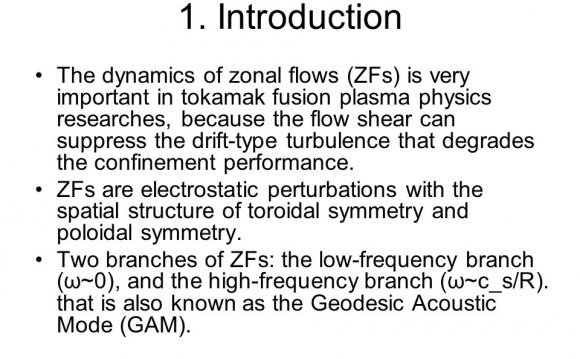
 Low-temperature plasmas have a huge range of technological and medical applications. These include plasma etching for semiconductor chip manufacture, plasma depostion (e.g. for solar cells or protective coatings), plasma TVs and new medical applications (e.g sterilisation, biocompatible materials). Research focusses on experiments and modelling to improve understanding of the plasma proceses and thereby optimise applications and develop new ones.
Low-temperature plasmas have a huge range of technological and medical applications. These include plasma etching for semiconductor chip manufacture, plasma depostion (e.g. for solar cells or protective coatings), plasma TVs and new medical applications (e.g sterilisation, biocompatible materials). Research focusses on experiments and modelling to improve understanding of the plasma proceses and thereby optimise applications and develop new ones.
- Non-linear theories and computational studies of tokamak plasma instabilities, including explosive plasma instabilities that may provide a model for so-called "ELM" events (an important scientific research area for ITER).
- Theoretical studies of the self-consistent interaction of energetic ions (produced either by fusion reactions or heating schemes) and plasma waves in tokamaks.
- Experimental and interpretive modelling studies of tokamak edge plasmas
- Diagnostic development for magnetically confined plasmas
- Investigating and understanding extreme ultra-violet laser action produced in plasmas formed from laser-heated solids
- Application of x-ray lasers to measure the opacity of plasmas relevant to the convection zone of the sun
- Experiments and modelling related to the development of Laser Fusion, particularly Re-entrant Cone-Guided Fast Ignition
- The study in the laboratory of plasmas relevant to astrophysical problems
- The effects of extreme electric fields on plasma emission
- Lower temperature plasmas of technological interest created by lasers
- Atmospheric pressure plasma jets are being explored for medical applications (e.g. sterilisation)
- Techniques to further improve the plasma etching processes in semi-conductor chip manufacture
- Microplasmas are being developed for a range of applications, including coordination of many small microplasmas into large 2D arrays
Fusion research is undertaken with a view to understanding the basic plasma physics processes in tokamaks to help reduce uncertainties in the performance of future tokamaks (ITER, in particular). There is a close collaboration with the Culham Science Centre, home of the JET and MAST tokamaks, which provides access to world-leading experimental tokamak facilities and additional expertise for our postgraduate students. We also have a linear magnetic confinement plasma device at the York Plasma Institute laboratories.
Laser plasma experiments are usually carried out at the Central Laser Facility, Rutherford Appleton Laboratory or at large European laser laboratories. A small in-house nanosecond laser in the York Plasma Institute laboratories is used to produce plasmas for testing diagnostics prior to experiments on larger facilities.
The York Plasma Institute laboratories will house a broad range of low-temperature plasma experiments. These include laboratories for atmospheric plasma jets, microplasmas, low-pressure plasma, laser spectroscopy and plasma etching. The emphasis is on 1) characterising and understanding the plasma properties, and 2) working with industry to improve existing technological applications of low-temperature plasmas and development of new ones.
YOU MIGHT ALSO LIKE


![[PDF Download] Controlled Fusion and Plasma Physics](/img/video/pdf_download_controlled_fusion_and_plasma.jpg)









